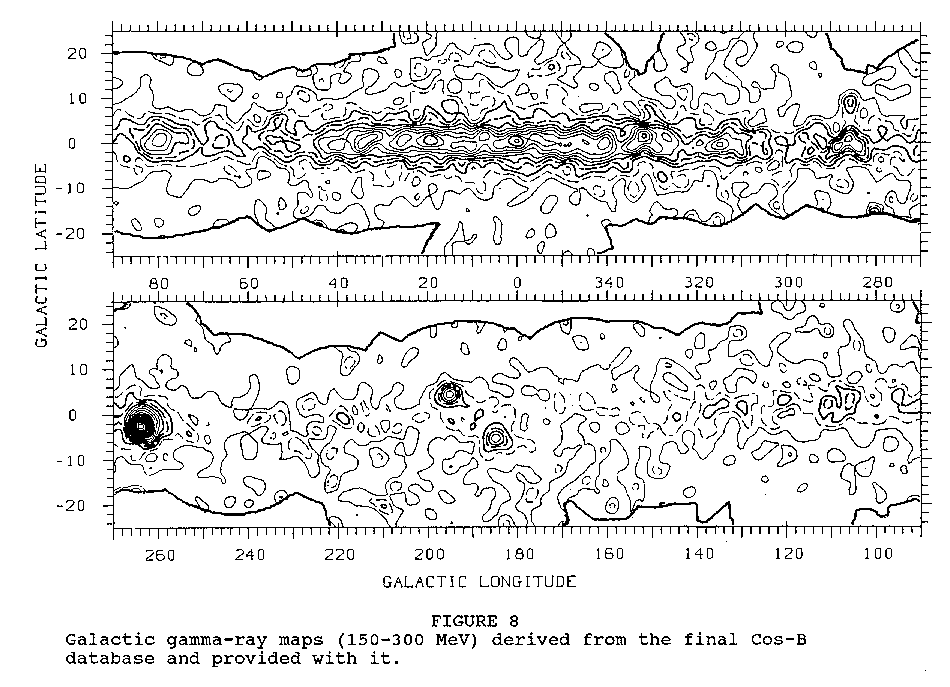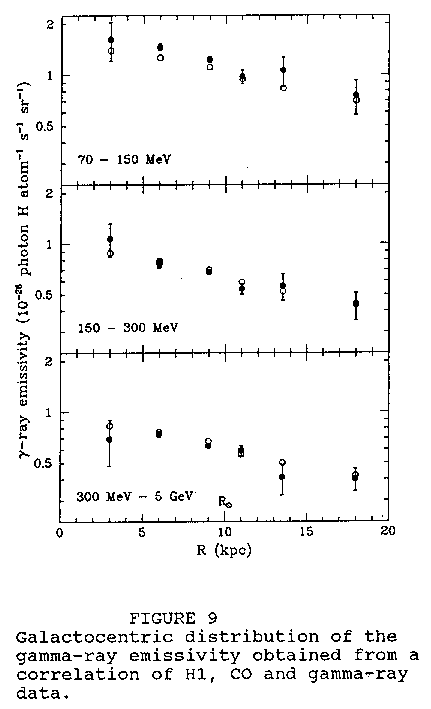Large Scale Galactic Emission - COS-B
Large Scale Galactic Emission
Most of the observations which have been performed with Cos-B have been devoted to the study of the galactic disc. A detailed and complete contour map of the galaxy seen in the light of gamma radiation is shown in Figure 8.
It has been derived from merging the data from all the low latitude observations in the final Cos-B database. Factors for changes in sensitivity have been incorporated in producing the map, which is based on about 200 000 gamma-ray events.
The presentation here is somewhat smoothed: a 150-300 MeV energy band is chosen to show the clumpiness of the data corresponding to identified and candidate sources.
The picture reveals galactic features of many scale sizes:
- Centre, width of emission unresolved
- Peak of emission follows galactic plane
- Arms and interarm regions
- Local emission out to mid latitudes (Perseus arm)
- The Vela source
- The anti-centre sources
- Other hot-spots (sources) in plane
These qualitative findings have been substantiated by quantitative correlations in which the gamma-ray emission is predicted from models of cosmic ray bombardment of interstellar gas. The important gas data required to do this properly has only recently become available from Wco/12CO observations of molecular hydrogen.
The observed galactic emission I(g) may be modelled by 3 components:
I(g) = (q(g)/4Π) [ N(H1) +2N(H2)] + I(b)where
q(g) = Gamma ray emissivity / atom N(H1) = H1 gas distribution (convolved) N(H2) = CO/H2 distribution (convolved, new surveys) I(b) = Background
Furthermore, as summarised by Bloemen (Ref.17), the model may be enhanced by considering not only the mass of gas but also its distance (as determined from its Doppler shift under a given model of the rotation of the galaxy). This may then be fitted with the observed gamma-ray emission by peeling off the measured HI and H2 emission into different volumes of origin. The Cos-B team has thereby correlated the observed gamma-ray emission with the hydrogen in six galactocentric annular rings. The data have been analysed to yield the gamma-ray emissivity values in the six galactocentric distance bands, and in three energy ranges.
The result is shown in Figure 9 taken from Bloemen (Ref.17) which presents evidence for a radial gradient of both cosmic-ray electrons i.e. those responsible for the bulk of the low-energy part of the gamma-ray emission, and nucleonic cosmic-rays. A proton gradient is seen to exist, though weaker than the electron one. This has moderated earlier claims (Ref.18) that the nucleonic cosmic rays may extend beyond our own galaxy.
Further evidence that gamma rays trace the distribution of matter in the galaxy has resulted from the large-scale correlation of intermediate latitude gamma rays with the total gas column as derived from galaxy counts (Ref.19). The gamma-ray emissivity derived from this method is locally in excellent agreement with that given by the comprehensive, low latitude galactic analysis of Strong et al. (Ref.20).
- Removed a total of (3) align=center.








































 Sign in
Sign in
 Science & Technology
Science & Technology

